
Most laborers in Peru are forced into a vicious cycle by circumstance. Faced with low-paying, high-intensity work, they have no choice but to make their children work as well. Having spent their lives neglecting education for labor, those children in turn grow up with no options for income besides low-paying, high-intensity positions — and so on. But in classrooms across one region, a handful of teachers are trying to break that cycle while the children are still young.
Passing out books every week in a tiny classroom that lies on the side of a dirt road, high up in the Andes overlooking the city of Cajamarca, volunteers are met with a crime that teachers would usually welcome — the children are trying to sneak out extra books so that they can read more, IPS reported.
When they first begin coming to classes, virtually all of the children have self-esteem so low that they are cripplingly shy and can barely speak to others.
Once each has a book the air is filled with high voices while they excitedly compare with one another, sometimes swapping between friends, exclaiming in thrill.
Each one of them is a child laborer.
The overwhelming majority work in brick yards, although some in nearby towns work loading and unloading carts of fruit from trucks in the crowded mercado; as construction workers helping to build houses by carrying cement and heavy tools; farm hands; maids; or simply wandering the streets for hours picking up bottles for recycling departments.
The miniature brick workers — all aged around six years old — rise at six in the morning and walk for several hours to get to their work sites. They spend all day in the mud, molding dirt into bricks; carrying loads into large, industrial ovens; hauling piles of finished bricks into trucks; and unloading the same loads in construction sites and crowded mercados.
It’s a job that consumes a child’s daily life, taking up any time that he or she is not in school. The work gradually eats in to school hours themselves more and more until the children eventually drop out completely around age 12, to allow themselves to spend more time working and earn a larger income. Unsurprisingly, almost all of them are constantly ill and malnourished.
